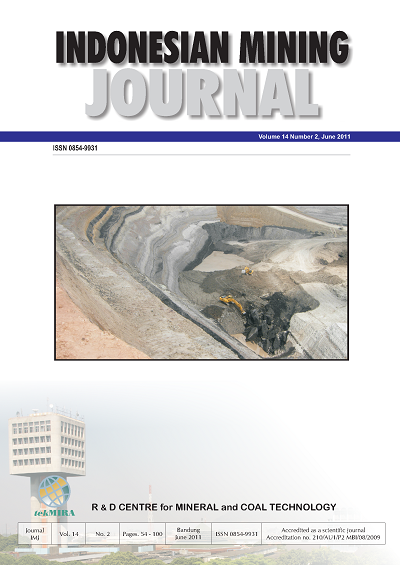STRUCTURAL CHANGES OF POMALAA LATERITIC ORE DUE TO COAL-BASED MAGNETIZING ROASTING
DOI:
https://doi.org/10.30556/imj.Vol14.No2.2011.497Keywords:
reduction, iron ores, limonitic ores, magnetizing roastingAbstract
Overburden of Indonesia’s laterite ore at Pomalaa is considered as an iron cap. It performs low iron grade (41.88%) and high silica and aluminum oxide contents (18.47% and 9.46%, respectively). Around 54.74% of size distribution belong to -325 mesh fraction. Limonite iron mineral dominates in the ore in the range of 80-90% with water content of about 40%. Proven deposits of laterite iron ore are about 222 million tons. As a significant resources iron ore to be used as raw material for iron and steel industries, the iron content must be upgraded to meet the requirement of iron making industry.
Magnetizing roasting technique can be conducted to change the paramagnetic iron mineral (such as hema- tite, goethite, limonite or siderite) into magnetite one that has high magnetic intensity. Therefore, the changed iron mineral can be concentrated using low-intensity, magnetic separator. Coal, mixed in ore composite may also enhance the development of coal-based magnetizing roasting processes in order to reach the desired temperature. Recently, reduced iron products from many different processes have been used as the main feed mixed with steel scrap. On the other hand, iron ore resources is getting dominated by low grade lateritic iron ore with specific content of water crystal. The abundant deposits of low grade lateritic iron ore and low rank coal in Indonesia can be used as suitable resources for raw materials in the iron and steel- making industry.
Iron structural changes during magnetizing roasting process using coal as reductant agent was observed. The result showed that the non-magnetic limonite ore has been changed in to metallic iron and the iron recovery in the magnetic product depended on the coal ratio in the pellet composite. The magnetic product can be used for the development of lateritic iron ore as one of the alternatives to metallized iron feed for iron making industry.
References
Gupta, R.C. and Misra, S.N., 2001. Composite Pre- reduced Pellet Quality as Affected by Reductant Reactivity, ISIJ International, v.41 Supplement, PD.S9-S12.
Purwanto, H. and Pramusanto, 2009. Effect of Magnetation on the Leaching of Limonitic Ore, Conf. Proc. RAMM & ASMP 2009, 1st – 3rd June 2009, Penang, Malaysia.
Meyer, K., 1980. Pelletizing of Iron Ores, Springer- Verlag, Dusseldorf, pp50-60.
Shimizu, M., Nomura, Y., Ohno, K., Maeda, T., and Nishioka, K., 2007. Rapid in-flight of fine ore transported by CH4 gas, Proc. Japan-Indo. Bi- lateral Symp. On Sustainable Eng., Surabaya.
Stephenson, R.L., 1983. The Significant of Direct Reduction, The Iron & Steel Society of AIME.
Stephenson, R.L. and Larson, N., 1980. Direct Re- duced Iron, Technology and Economics of Pro- duction and Use, The Iron and Steel Society of AIME, USA.
Sohn, H.Y. and Wadsworth, M.E., 1979. Rate Pro- cesses of Extractive Metallurgy, Plenum Press, New York.
Supriyanto, S., Nababan, M., and Pramusanto, 2009. Coal based lateritic Iron ore reduction: Kinetic analysis, Proc. The 2nd International Symposium of Novel Carbon Resource Science, March 10- 11, 2009, ITB, Bandung.
Wynnyckyj, J.R. and Ruskin, W.J., 1988. An Intrinsic- Transport Model for Solid- Solid Reaction Involv- ing Gaseous Intermediate, Metallurgical Trans- action B, V.19B.
Downloads
Issue
Section
License
Indonesian Mining Journal provides immediate open access to its content on the principle that making research freely available to the public to supports a greater global exchange of knowledge.

This work is licensed under a Creative Commons Attribution-NonCommercial 4.0 International License.













